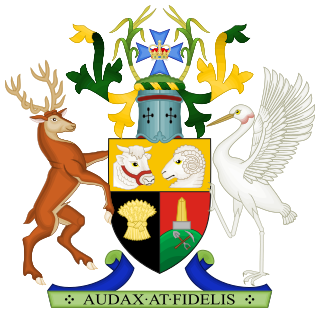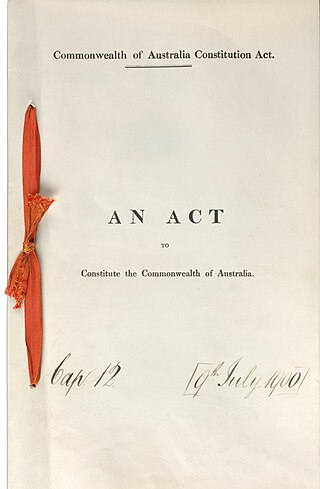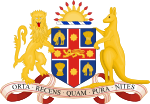In law, especially English and American common law, quo warranto is a prerogative writ requiring the person to whom it is directed to show what authority they have for exercising some right, power, or franchise they claim to hold. Quo warranto is also used, with slightly different effect, in the Philippines.

The Australian Electoral Commission (AEC) is the independent statutory authority and agency of the Australian Government responsible for the management of federal Australian elections, by-elections and referendums.
Australian constitutional law is the area of the law of Australia relating to the interpretation and application of the Constitution of Australia. Legal cases regarding Australian constitutional law are often handled by the High Court of Australia, the highest court in the Australian judicial system. Several major doctrines of Australian constitutional law have developed.

The Parliament of Victoria is the bicameral legislature of the Australian state of Victoria that follows a Westminster-derived parliamentary system. It consists of the King, represented by the Governor of Victoria, the Legislative Assembly and the Legislative Council. It has a fused executive drawn from members of both chambers. The parliament meets at Parliament House in the state capital Melbourne. The current Parliament was elected on 26 November 2022, sworn in on 20 December 2022 and is the 60th parliament in Victoria.

The Government of New South Wales, also known as the NSW Government, is the democratic administrative authority in New South Wales, Australia, and is empowered by the state Constitution. Since Federation in 1901, New South Wales has been a state of Australia, and the federal Constitution regulates its relationship with the Commonwealth. Under the Australian Constitution, all states ceded legislative and judicial supremacy, but retained powers in all matters not in conflict with the Commonwealth.

The Supreme Court of New South Wales is the highest state court of the Australian State of New South Wales. It has unlimited jurisdiction within the state in civil matters, and hears the most serious criminal matters. Whilst the Supreme Court is the highest New South Wales court in the Australian court hierarchy, an appeal by special leave can be made to the High Court of Australia.
The separation of powers in Australia is the division of the institutions of the Australian government into legislative, executive and judicial branches. This concept is where legislature makes the laws, the executive put the laws into operation, and the judiciary interprets the laws; all independently of each other. The term, and its occurrence in Australia, is due to the text and structure of the Australian Constitution, which derives its influences from democratic concepts embedded in the Westminster system, the doctrine of "responsible government" and the United States version of the separation of powers. However, due to the conventions of the Westminster system, a strict separation of powers is not always evident in the Australian political system, with little separation between the executive and the legislature, with the executive required to be drawn from, and maintain the confidence of, the legislature; a fusion.

Sue v Hill was an Australian court case decided in the High Court of Australia on 23 June 1999. It concerned a dispute over the apparent return of a candidate, Heather Hill, to the Australian Senate in the 1998 federal election. The result was challenged on the basis that Hill was a dual citizen of the United Kingdom and Australia, and that section 44(i) of the Constitution of Australia prevents any person who is the citizen of a "foreign power" from being elected to the Parliament of Australia. The High Court found that, at least for the purposes of section 44(i), the United Kingdom is a foreign power to Australia.

The New South Wales Electoral Commission is a statutory integrity agency with responsibility for the administration, organisation, and supervision of elections in New South Wales. It reports to the NSW Department of Premier and Cabinet.

The Land and Environment Court of New South Wales is a court within the Australian court hierarchy established pursuant to the Land and Environment Court Act 1979 (NSW) to hear environmental, development, building and planning disputes. The Court’s jurisdiction, confined to the state of New South Wales, Australia, includes merits review, judicial review, civil enforcement, criminal prosecution, criminal appeals and civil claims about planning, environmental, land, mining and other legislation.

The Industrial Court of New South Wales was a court within the Australian court hierarchy that exercised the judicial functions of the Industrial Relations Commission of New South Wales within the Australian state of New South Wales. The Commission has exclusive jurisdiction in respect of industrial disputes in that state.

The Court of Disputed Returns in Australia is a special jurisdiction of the High Court of Australia. The High Court, sitting as the Court of Disputed Returns, hears challenges regarding the validity of federal elections. The jurisdiction is twofold: (1) on a petition to the Court by an individual with a relevant interest or by the Australian Electoral Commission, or (2) on a reference by either house of the Commonwealth Parliament. This jurisdiction was initially established by Part XVI of the Commonwealth Electoral Act 1902 and is now contained in Part XXII of the Commonwealth Electoral Act 1918. Challenges regarding the validity of State elections are heard by the Supreme Court of that State as the State's Court of Disputed Returns.
The Court of Disputed Returns is a court, tribunal, or some other body that determines disputes about elections in some common law countries. The court may be known by another name such as the Court of Disputed Elections. In countries that derive their legal tradition from the United Kingdom, the legal tradition is that Parliament is the supreme law-making body in the country. The same tradition mandates that as Parliament is sovereign, it alone has authority and jurisdiction to determine who and how a person can be elected to Parliament. Implicit in that authority is the jurisdiction to determine whether a person has been validly elected, which is commonly known as a "disputed return" and gives the court its name. The court is an attempt to eliminate the partisan nature of parliament and give the determination of electoral disputes to an independent and dispassionate neutral body. As parliament has the sole authority to determine these matters, parliament must create a special law to bring that body into existence to determine those disputes.

The Queensland Court of Disputed Returns is a court that adjudicates disputes concerning Queensland Government and local government elections and state referendums in Queensland, Australia. The Court is a division of the Supreme Court of Queensland.

The Constitution of Australia is the supreme law of Australia. It is a written constitution that sets down the political structure of Australia as a federation under a constitutional monarchy governed with a parliamentary system and outlines the structure and powers of the Commonwealth of Australia's three constituent parts: the executive, legislature, and judiciary.
The Entrance, an electoral district of the Legislative Assembly in the Australian state of New South Wales, was created in 1988 as part of a redistribution of seats following the expansion of the Assembly from 99 to 109 seats.

The Constitution Act 1902 is the founding document of the State of New South Wales, and sets out many of the basic principles of the Government of New South Wales. This act created the foundation of the Executive, Legislative and Judicial branches of the Government of New South Wales. Most of the Constitution can be amended through ordinary Acts of Parliament, however some sections can only be amended through a referendum of NSW voters.
A by-election was held for the New South Wales Legislative Assembly electorate of Gordon on 24 September 1938 because the Court of Disputed Returns overturned the result of the 1938 Gordon election. Harry Turner had been declared elected by 9 votes over William Milne. Both candidates were endorsed by the United Australia Party. Milne filed a petition which challenged postal and absentee votes. Justice Maxwell sitting as the Court of Disputed Returns held that most of the 125 challenged votes did not meet the requirement of the Electoral Act such as not being properly witnessed, and that the election was void.
In October 1894 the Elections and Qualifications Committee conducted a re-count of the 1894 Grenfell election, in which George Greene had been declared elected by a margin of 2 votes over Michael Loughnane (Labor). The Elections and Qualifications Committee consisted of 9 members, 5 Free Trade and four Protectionist.
There have been 18 referendums in New South Wales, 8 of which concerned proposals to amend the New South Wales Constitution, half of which concerned the Legislative Council. While the Constitution of Australia was adopted after the 1898 and 1899 referendums in all of the proposed states, the constitution of New South Wales, promulgated in 1902, was an Act of the Parliament of New South Wales which could be amended by parliament. Since 1927 the constitution has included provisions that can only be amended following approval in a referendum. 8 of the referendums, including 5 on the sale of alcohol, did not involve any proposed amendment to the constitution. While these have traditionally been called referendums, they could also be described as plebiscites.









